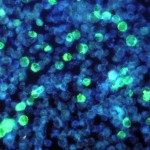Link to Pubmed [PMID] – 31378988
J. Leukoc. Biol. 2019 Aug;
This work sought to confirm the human-like expression of exhaustion and senescence markers in a mouse model with a humanized immune system (HIS): the Balb/c Rag2 IL2rgc Sirpα Flk2 HLA-A2 (BRGSF-A2) mouse reconstituted with human CD34 cord blood cells. With regard to senescence markers, the percentage of CD57 T cells was higher in the bone marrow (BM) than in the spleen or blood. The same was true for KLRG1 hCD8 T cells. With regard to exhaustion markers, the percentage of programmed death 1 (PD-1 ) T cells was higher in the BM than in the spleen or blood; the same was true for TIGIT hCD4 cells. These tissue-specific differences were related to both higher proportions of memory T cells in BM and intrinsic differences in expression within the memory fraction. In blood samples from HIS mice and healthy human donors (HDs), we found that the percentage of KLRG1 cells among hCD8 T cells was lower in HIS compared to HDs. The opposite was true for CD4 T cells. Unexpectedly, a high frequency of KLRG1 cells was observed among naive T cells in HIS mice. CD57 expression on T cells was similar in blood samples from HIS mice and HDs. Likewise, PD-1 expression was similar in the two systems, although a relatively low proportion of HIS hCD4 T cells expressed TIGIT. The BRGSF-A2 HIS mouse’s exhaustion and senescence profile was tissue specific and relatively human like; hence, this mouse might be a valuable tool for determining the preclinical efficacy of immunotherapies.


